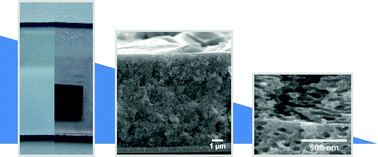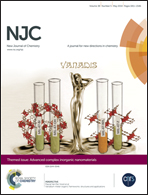Thick titania films with hierarchical porosity assembled from ultrasmall titania nanoparticles as photoanodes for dye-sensitized solar cells
Abstract
Thin mesoporous titania films prepared by surfactant templating feature some of the highest light conversion efficiencies per thickness ratios as anodes in dye-sensitized solar cells (DSCs). However, the fabrication of thicker films required for sufficient light absorption is very challenging using this approach, often resulting in cracking and delamination of the films. Here we present a simple and scalable method to prepare thick mesoporous titania photoanodes via a surfactant-directed assembly of crystalline ultra-small TiO2 nanoparticles in combination with phase separation due to ethyl cellulose added to the coating solutions. Along with increasing film thickness, the ethyl cellulose introduces an interpenetrating macropore network into the films, leading to the formation of hierarchical porous films with bimodal porosity, with the smaller mesopores resulting from the structure-directing agent, Pluronic F127. In this way, films of up to 2 μm per layer without delamination can be produced, exhibiting a high surface area of 130 m2 g−1, about twice the value of films based on standard TiO2 nanoparticle paste. The preparation of multilayer films by a sequential spin-coating and calcination procedure enables the production of films with an overall thickness of up to 10 μm in only 5 steps, which showed high efficiencies of 7.7% in dye-sensitized solar cells.

- This article is part of the themed collection: Advanced Complex Inorganic Nanomaterials

 Please wait while we load your content...
Please wait while we load your content...